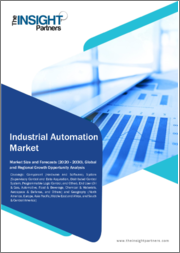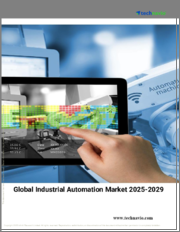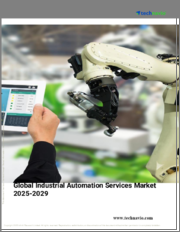
|
시장보고서
상품코드
1362432
산업 자동화 시장 규모 및 동향, 세계 및 지역별 점유율, 동향, 성장 기회 분석 보고서 범위 : 구성요소별, 시스템별, 최종사용자별Industrial Automation Market Size and Forecasts, Global and Regional Share, Trends, and Growth Opportunity Analysis Report Coverage: By Component, System, and End User |
||||||
산업 자동화 시장 규모는 2022년 1,712억 3,000만 달러로 평가되며 2030년에는 3,226억 7,000만 달러에 달할 것으로 예상되며, 2022-2030년간 연평균 8.2%의 CAGR을 나타낼 것으로 예상됩니다.
머신비전 사용자와 시스템 통합사업자들은 지난 40년 가까이 더 나은 이미지, 광학, 조명, 소프트웨어를 활용해 왔습니다. 머신비전은 어느 정도 성숙한 기술이지만, 부품, 소프트웨어, 엔지니어링 비용의 감소, 사용 편의성 향상, 용도의 확장으로 인해 업계 전반에서 머신비전의 수용이 계속 증가하고 있습니다.
2021년, 코로나19의 대유행으로 인해 제조업체들이 최대한 효율적으로 운영되고, 기업이 디지털 인프라를 강화하고, 원격 근무자를 지원하기 위해 분주하게 움직이면서, 증가하는 수요에 대응하기 위해 산업 자동화에 머신비전 기술을 도입하는 속도가 빨라졌습니다. 산업 자동화 시장의 성장을 더욱 촉진하고 있습니다.
또한, 온라인 구매량이 급증하면서 물류 관련 앱도 증가했습니다. 소매 유통 센터의 이미지 처리 시스템, 자동 창고 보관 및 검색 시스템, 마스크, 안면 보호대, 방호복, 인공호흡기 등 PPE 관련 품목 제조업체 등이 그 예다. 산업 자동화용 머신비전 시스템 보급에 영향을 미치는 다른 요인으로는 예지보전, 포장 검사, 자동 바코드 판독, 제품 및 부품 조립, 결함 감소, 3D 비전 검사 등을 꼽을 수 있습니다.
또한, 산업 자동화를 위한 머신비전 기술을 통해 새로운 제품을 개발하기 위한 기업들의 투자 증가는 산업 자동화 시장의 성장을 더욱 촉진하고 있습니다. 예를 들어, 2022년 1월 크로노스 그룹은 EMVA(European Machine Vision Alliance)와 함께 임베디드, 모바일, 산업, XR, 자동차 및 과학 산업에서 카메라 시스템의 런타임을 규제하기 위한 개방형 로열티 없는 API 표준을 만드는 새로운 이니셔티브를 시작했습니다. 이처럼 기업들의 투자 증가는 산업 자동화 시장의 성장을 견인하고 있습니다.
유럽은 제조 시설 전체에 로봇 시스템을 가장 먼저 도입한 국가 중 하나입니다. 또한, IoT 기반 기술의 신흥 시장으로 인해 로봇 채택이 증가하면서 이 지역의 산업 자동화 시장 성장에 힘을 실어주고 있습니다. 유럽위원회(EC)는 제조업의 경쟁력을 높이고 세계 기술 리더로서의 우위를 유지하기 위해 자동화 분야의 R&D 자금에 중점을 두고 있으며, 2018년부터 2020년까지 AI, 코봇과 같은 로봇 공학 및 기타 기술의 R&D에 7억 달러(한화 약 8,000억 원)를 투자할 계획입니다. 7억 8,000만 달러의 예산을 책정했습니다.
자동차 부문은 새로운 생산 능력과 인더스트리 4.0 인프라에 대규모 투자를 하고 있습니다. 자동차 부문은 로봇의 최종 이용 산업으로 유럽 로봇 출하량의 절반을 차지하며 산업 자동화 시장의 성장을 주도하고 있습니다. 자동차 조립 자동화에는 자재 취급, 용접, 차체 부품 조립과 같은 반복적인 공정의 간소화가 포함됩니다. 자동차 제조업체는 비전, 로봇 공학 및 소프트웨어의 통합을 통해 수작업과 인건비를 줄이고 품질과 반복성을 향상시킬 수 있습니다. 유럽에는 BMW, 폭스바겐, 르노, 푸조 등 유명 자동차 제조업체가 많습니다. 따라서 탄탄한 자동차 산업은 이 지역의 자동화 솔루션 채택을 촉진하고 산업 자동화 시장의 성장을 주도하고 있습니다.
프랑스는 기술 선진국이자 독일, 영국에 이어 유럽에서 세 번째로 큰 경제 대국입니다. 프랑스는 제조업이 발달하고 세계 기술 선진국 중 하나로 유명하기 때문에 이 지역의 포장 로봇의 주요 시장 중 하나입니다. 자재 취급은 픽 앤 플레이스, 팔레 타이 징, 포장과 같은 산업용 로봇을 사용하는 주요 응용 분야 중 하나입니다. 프랑스는 보다 생산적이고 진보된 제조업을 위해 산업용 IoT 및 기타 자동화 기술에서 큰 발전을 이루고 있습니다. 식음료, 항공우주, 금속 및 기계 분야는 효율성을 높이기 위해 로봇을 도입하고 있는 주요 제조업 분야 중 일부입니다. 푸조와 르노와 같은 자동차 제조업체들이 이 지역에 진출한 것도 자동화 솔루션에 대한 수요에 기여하고 있으며, 이는 산업 자동화 시장의 성장을 더욱 촉진하고 있습니다.
ABB Ltd.;Bosch Rexroth AG;에머슨 일렉트릭(Emerson Electric Co.;Hitachi, Ltd.;Honeywell International, Inc.;미쓰비시전기(주);오므론(Omron Corporation);Rockwell Automation, Inc. 시장과 그 생태계의 전체 그림을 파악하기 위해 다른 여러 주요 산업 자동화 시장 기업을 조사하고 분석합니다. 산업 자동화 시장 보고서는 상세한 시장 인사이트을 제공하고 주요 기업이 성장 전략을 수립하는 데 도움이 될 것입니다.
목차
제1장 서론
제2장 주요 요약
- 주요 인사이트
- 시장의 매력
제3장 조사 방법
- 조사 범위
- 2차 조사
- 1차 조사
제4장 산업 자동화 시장 구도
- PEST 분석
- 생태계 분석
- 밸류체인 벤더 리스트
제5장 산업 자동화 시장 : 주요 산업 역학
- 성장 촉진요인
- 시장 성장 억제요인
- 시장 기회
- 향후 동향
- 성장 촉진요인과 억제요인의 영향
제6장 산업 자동화 시장 : 세계 시장 분석
- 산업 자동화 시장 개요
- 산업 자동화 시장 판매량, 2022년-2030년
- 산업 자동화 시장 예측과 분석
제7장 산업 자동화 시장 분석 : 컴포넌트
- 하드웨어
- 모터 및 드라이브
- 모터 및 드라이브
- 로봇
- 센서
- 머신 비전 시스템
- 기타
- 모터 및 드라이브
- 소프트웨어
제8장 산업 자동화 시장 분석 : 시스템
- 감시제어와 데이터 수집
- 시스템 개요
- 분산 제어 시스템
- 프로그래머블 로직 제어
- 기타
제9장 산업 자동화 시장 분석 : 최종사용자
- 자동차
- 석유 및 가스
- 식품 및 음료
- 화학·소재
- 항공우주 및 방위
- 기타
제10장 산업 자동화 시장 : 지역별 분석
- 북미
- 멕시코
- 유럽
- 기타 유럽
- 아시아태평양
- 호주
- 중국
- 인도
- 일본
- 한국
- 기타 아시아태평양
- 중동 및 아프리카
- 기타 중동 및 아프리카
- 중남미
- 기타 중남미
제11장 산업 자동화 시장 : COVID-19 팬데믹의 영향
- COVID-19 전후의 영향
제12장 경쟁 구도
- 주요 기업별 히트맵 분석
- 기업 포지셔닝과 집중도
제13장 업계 상황
- 시장 이니셔티브
- 제품 개발
제14장 기업 개요
- ABB Ltd
- Bosch Rexroth AG
- Emerson Electric Co
- Hitachi Ltd
- Honeywell International Inc
- Mitsubishi Electric Corp
- OMRON Corp
- Rockwell Automation Inc
- Schneider Electric SE
- Siemens AG
제15장 기업 개요 부록
LSH 23.10.24The industrial automation market size was valued at US$ 171.23 billion in 2022 and is expected to reach US$ 322.67 billion by 2030; it is estimated to record a CAGR of 8.2% from 2022 to 2030.
Machine vision users and systems integrators have exploited better imaging, optics, illumination, and software for nearly 40 years. Even though machine vision is a somewhat mature technology, lower component, software, and engineering costs and increased simplicity of use and application expansion continue to drive machine vision acceptance across industries.
In 2021, due to the COVID-19 pandemic, manufacturers accelerated the deployment of machine vision technology for industrial automation to keep operations running as effectively as possible and keep up with the increasing demand as businesses scrambled to bolster digital infrastructure, supporting remote workers, further propelling the growth of the industrial automation market.
Additionally, logistics-related apps experienced a rise due to a surge in online purchase volumes. Imaging systems in retail distribution centers and automated warehouse storage and retrieval systems, and manufacturers of PPE-related items, such as face masks, face shields, protective garments, and respirators were among them. Other factors influencing the uptake of machine vision systems for industrial automation include predictive maintenance, packaging inspection, automated barcode reading, product and component assembly, defect reduction, and 3D vision inspection.
Moreover, the rise in investment by companies to develop new products through machine vision technology for industrial automation is further propelling the industrial automation market growth. For instance, in January 2022, the Khronos Group launched a new initiative with the European Machine Vision Alliance (EMVA) to produce an open, royalty-free API standard to regulate camera system runtimes in embedded, mobile, industrial, XR, automotive, and scientific industries. Thus, the rise in investments by companies is boosting the industrial automation market growth.
Europe is one of the early adopters of robotics systems across manufacturing facilities. Furthermore, the ongoing developments in IoT-based technologies are rising the adoption of robots, propelling the growth of the industrial automation market in the region. The European Commission (EC) is primarily focusing on R&D funding in automation to boost the competitiveness of its manufacturing sector and continue dominance in global technological leadership. EC sanctioned a budget of US$ 780 million for R&D in robotics and other technologies, such as AI and Cobots, from 2018 to 2020.
The automotive sector invests extensively in new production capabilities and the industry 4.0 infrastructure. The automotive sector is a leading end-use industry for robotic applications, accounting for half of the robot shipments in Europe, fueling the growth of the industrial automation market. Automotive assembly automation involves streamlining repetitive processes, such as material handling, welding, and assembling auto body components. Automotive manufacturers can save on rework and labor costs and improve quality and repeatability with vision, robotics, and software integration. Europe is home to many prominent car manufacturers, including BMW, Volkswagen, Renault, and Peugeot. Thus, the robust automotive industry is boosting the adoption of automated solutions in the region, which is driving the growth of the industrial automation market.
France is a technologically advanced country and is the third-largest economy in Europe, after Germany and the United Kingdom. France is one of the major markets for packaging robots in the region due to its robust manufacturing industry and is renowned among the technologically advanced countries in the world. Material handling is one of the major applications employing industrial robots for pick & place, palletizing and packaging. France is making significant developments in industrial IoT and other automation technologies for more productive and advanced manufacturing sector. Food & beverage, aerospace, metals & machinery are some of the major manufacturing sectors that are increasingly adopting robots for increased efficiency. The presence of automakers such as Peugeot and Renault in the region contributes to the demand for automated solutions, further fueling the growth of the industrial automation market.
ABB Ltd.; Bosch Rexroth AG; Emerson Electric Co.; Hitachi Ltd.; Honeywell International, Inc.; Mitsubishi Electric Corporation; Omron Corporation; Rockwell Automation, Inc.; Schneider Electric SE; and Siemens AG are among the key industrial automation market players profiled in the report. Several other major industrial automation market players were studied and analyzed during this market research study to get a holistic view of the market and its ecosystem. The industrial automation market report provides detailed market insights, which helps the key players strategize their growth.
Reasons to Buy:
- Save and reduce time carrying out entry-level research by identifying the growth, size, leading players and segments in the industrial automation market
- Highlights key business priorities in order to assist companies to realign their business strategies
- The key findings and recommendations such as specific country and segmental insight highlights crucial progressive industry trends in the industrial automation market, thereby allowing players across the value chain to develop effective long-term strategies
- Develop/modify business expansion plans by using substantial growth offering developed and emerging markets
- Scrutinize in-depth market trends and outlook coupled with the factors driving the market, as well as those hindering it
- Enhance the decision-making process by understanding the strategies that underpin commercial interest with respect to client products, segmentation, pricing and distribution
Table Of Contents
1. Introduction
- 1.1 The Insight Partners Research Report Guidance
- 1.2 Market Segmentation
2. Executive Summary
- 2.1 Key Insights
- 2.2 Market Attractiveness
3. Research Methodology
- 3.1 Coverage
- 3.2 Secondary Research
- 3.3 Primary Research
4. Industrial Automation Market Landscape
- 4.1 Overview
- 4.2 PEST Analysis
- 4.3 Ecosystem Analysis
- 4.3.1 List of Vendors in the Value Chain:
5. Industrial Automation Market - Key Industry Dynamics
- 5.1 Drivers
- 5.1.1 Rising Uptake of Automation across Food & Beverage Industry
- 5.1.2 Increase in Machine Vision Systems Adoption for Industrial Automation
- 5.2 Market Restraints
- 5.2.1 Requirement of High Initial Investment
- 5.3 Market Opportunities
- 5.3.1 Integration of Robotics in the Construction Industry
- 5.4 Future Trends
- 5.4.1 Surging Demand for Automation in the E-commerce Industry
- 5.5 Impact of Drivers and Restraints:
6. Industrial Automation Market - Global Market Analysis
- 6.1 Industrial Automation Market Overview
- 6.2 Industrial Automation Market Revenue (US$ Billion), 2022 - 2030
- 6.3 Industrial Automation Market Forecast and Analysis
7. Industrial Automation Market Analysis - Component
- 7.1 Hardware
- 7.1.1 Overview
- 7.1.2 Hardware Market Revenue and Forecasts To 2030 (US$ Billion)
- 7.1.3 Motors and Drives
- 7.1.3.1 Overview
- 7.1.4 Robots
- 7.1.4.1 Overview
- 7.1.5 Sensors
- 7.1.5.1 Overview
- 7.1.6 Machine Vision Systems
- 7.1.6.1 Overview
- 7.1.7 Others
- 7.1.7.1 Overview
- 7.2 Software
- 7.2.1 Overview
- 7.2.2 Software Market Revenue and Forecasts To 2030 (US$ Billion)
8. Industrial Automation Market Analysis - System
- 8.1 Supervisory Control and Data Acquisition
- 8.1.1 Overview
- 8.1.2 Supervisory Control and Data Acquisition Market Revenue and Forecasts To 2030 (US$ Billion)
- 8.2 Distributed Control System
- 8.2.1 Overview
- 8.2.2 Distributed Control System Market Revenue and Forecasts To 2030 (US$ Billion)
- 8.3 Programmable Logic Control
- 8.3.1 Overview
- 8.3.2 Programmable Logic Control Market Revenue and Forecasts To 2030 (US$ Billion)
- 8.4 Others
- 8.4.1 Overview
- 8.4.2 Others Revenue and Forecasts To 2030 (US$ Billion)
9. Industrial Automation Market Analysis - End User
- 9.1 Automotive
- 9.1.1 Overview
- 9.1.2 Automotive Market Revenue and Forecasts To 2030 (US$ Billion)
- 9.2 Oil and Gas
- 9.2.1 Overview
- 9.2.2 Oil and Gas Market Revenue and Forecasts To 2030 (US$ Billion)
- 9.3 Food and Beverage
- 9.3.1 Overview
- 9.3.2 Food and Beverage Market Revenue and Forecasts To 2030 (US$ Billion)
- 9.4 Chemicals and Materials
- 9.4.1 Overview
- 9.4.2 Chemicals and Materials Market Revenue and Forecasts To 2030 (US$ Billion)
- 9.5 Aerospace and Defense
- 9.5.1 Overview
- 9.5.2 Aerospace and Defense Market Revenue and Forecasts To 2030 (US$ Billion)
- 9.6 Others
- 9.6.1 Overview
- 9.6.2 Others Market Revenue and Forecasts To 2030 (US$ Billion)
10. Industrial Automation Market - Geographical Analysis
- 10.1 North America
- 10.1.1 North America Industrial Automation Market Overview
- 10.1.2 North America Industrial Automation Market Revenue and Forecasts to 2030 (US$ Mn)
- 10.1.3 North America Industrial Automation Market Breakdown by Component
- 10.1.3.1 North America Industrial Automation Market Revenue and Forecasts To 2030 (US$ Mn) - By Component
- 10.1.4 North America Industrial Automation Market Breakdown by System
- 10.1.4.1 North America Industrial Automation Market Revenue and Forecasts To 2030 (US$ Mn) - By System
- 10.1.5 North America Industrial Automation Market Breakdown by End User
- 10.1.5.1 North America Industrial Automation Market Revenue and Forecasts To 2030 (US$ Mn) - By End User
- 10.1.6 North America Industrial Automation Market Revenue and Forecasts and Analysis - By Countries
- 10.1.6.1 US Industrial Automation Market Revenue and Forecasts to 2030 (US$ Mn)
- 10.1.6.1.1 US Industrial Automation Market Breakdown by Component
- 10.1.6.1.2 US Industrial Automation Market Breakdown by System
- 10.1.6.1.3 US Industrial Automation Market Breakdown by End User
- 10.1.6.2 Canada Industrial Automation Market Revenue and Forecasts to 2030 (US$ Mn)
- 10.1.6.2.1 Canada Industrial Automation Market Breakdown by Component
- 10.1.6.2.2 Canada Industrial Automation Market Breakdown by System
- 10.1.6.2.3 Canada Industrial Automation Market Breakdown by End User
- 10.1.6.3 Mexico Industrial Automation Market Revenue and Forecasts to 2030 (US$ Mn)
- 10.1.6.3.1 Mexico Industrial Automation Market Breakdown by Component
- 10.1.6.3.2 Mexico Industrial Automation Market Breakdown by System
- 10.1.6.3.3 Mexico Industrial Automation Market Breakdown by End User
- 10.1.6.1 US Industrial Automation Market Revenue and Forecasts to 2030 (US$ Mn)
- 10.2 Europe
- 10.2.1 Europe Industrial Automation Market Overview
- 10.2.2 Europe Industrial Automation Market Revenue and Forecasts to 2030 (US$ Mn)
- 10.2.3 Europe Industrial Automation Market Breakdown by Component
- 10.2.3.1 Europe Industrial Automation Market Revenue and Forecasts and Analysis - By Component
- 10.2.4 Europe Industrial Automation Market Breakdown by System
- 10.2.4.1 Europe Industrial Automation Market Revenue and Forecasts and Analysis - By System
- 10.2.5 Europe Industrial Automation Market Breakdown by End User
- 10.2.5.1 Europe Industrial Automation Market Revenue and Forecasts and Analysis - By End User
- 10.2.6 Europe Industrial Automation Market Revenue and Forecasts and Analysis - By Countries
- 10.2.6.1 France Industrial Automation Market Revenue and Forecasts to 2030 (US$ Mn)
- 10.2.6.1.1 France Industrial Automation Market Breakdown by Component
- 10.2.6.1.2 France Industrial Automation Market Breakdown by System
- 10.2.6.1.3 France Industrial Automation Market Breakdown by End User
- 10.2.6.2 Germany Industrial Automation Market Revenue and Forecasts to 2030 (US$ Mn)
- 10.2.6.2.1 Germany Industrial Automation Market Breakdown by Component
- 10.2.6.2.2 Germany Industrial Automation Market Breakdown by System
- 10.2.6.2.3 Germany Industrial Automation Market Breakdown by End User
- 10.2.6.3 UK Industrial Automation Market Revenue and Forecasts to 2030 (US$ Mn)
- 10.2.6.3.1 UK Industrial Automation Market Breakdown by Component
- 10.2.6.3.2 UK Industrial Automation Market Breakdown by System
- 10.2.6.3.3 UK Industrial Automation Market Breakdown by End User
- 10.2.6.4 Italy Industrial Automation Market Revenue and Forecasts to 2030 (US$ Mn)
- 10.2.6.4.1 Italy Industrial Automation Market Breakdown by Component
- 10.2.6.4.2 Italy Industrial Automation Market Breakdown by System
- 10.2.6.4.3 Italy Industrial Automation Market Breakdown by End User
- 10.2.6.5 Russia Industrial Automation Market Revenue and Forecasts to 2030 (US$ Mn)
- 10.2.6.5.1 Russia Industrial Automation Market Breakdown by Component
- 10.2.6.5.2 Russia Industrial Automation Market Breakdown by System
- 10.2.6.5.3 Russia Industrial Automation Market Breakdown by End User
- 10.2.6.6 Rest of Europe Industrial Automation Market Revenue and Forecasts to 2030 (US$ Mn)
- 10.2.6.6.1 Rest of Europe Industrial Automation Market Breakdown by Component
- 10.2.6.6.2 Rest of Europe Industrial Automation Market Breakdown by System
- 10.2.6.6.3 Rest of Europe Industrial Automation Market Breakdown by End User
- 10.2.6.1 France Industrial Automation Market Revenue and Forecasts to 2030 (US$ Mn)
- 10.3 Asia Pacific Industrial Automation Market
- 10.3.1 Overview
- 10.3.2 Asia Pacific Industrial Automation Market Revenue and Forecasts To 2030 (US$ Billion)
- 10.3.3 Asia Pacific Industrial Automation Market Breakdown by Component
- 10.3.3.1 Asia Pacific Industrial Automation Market Revenue and Forecasts and Analysis - By Component
- 10.3.4 Asia Pacific Industrial Automation Market Breakdown by System
- 10.3.4.1 Asia Pacific Industrial Automation Market Revenue and Forecasts and Analysis - By System
- 10.3.5 Asia Pacific Industrial Automation Market Breakdown by End User
- 10.3.5.1 Asia Pacific Industrial Automation Market Revenue and Forecasts and Analysis - By End User
- 10.3.6 Industrial Automation Market Breakdown by Countries
- 10.3.6.1 Australia Industrial Automation Market Revenue and Forecasts to 2030 (US$ Mn)
- 10.3.6.1.1 Australia Industrial Automation Market Breakdown by Component
- 10.3.6.1.2 Australia Industrial Automation Market Breakdown by System
- 10.3.6.1.3 Australia Industrial Automation Market Breakdown by End User
- 10.3.6.2 China Industrial Automation Market Revenue and Forecasts to 2030 (US$ Mn)
- 10.3.6.2.1 China Industrial Automation Market Breakdown by Component
- 10.3.6.2.2 China Industrial Automation Market Breakdown by System
- 10.3.6.2.3 China Industrial Automation Market Breakdown by End User
- 10.3.6.3 India Industrial Automation Market Revenue and Forecasts to 2030 (US$ Mn)
- 10.3.6.3.1 India Industrial Automation Market Breakdown by Component
- 10.3.6.3.2 India Industrial Automation Market Breakdown by System
- 10.3.6.3.3 India Industrial Automation Market Breakdown by End User
- 10.3.6.4 Japan Industrial Automation Market Revenue and Forecasts to 2030 (US$ Mn)
- 10.3.6.4.1 Japan Industrial Automation Market Breakdown by Component
- 10.3.6.4.2 Japan Industrial Automation Market Breakdown by System
- 10.3.6.4.3 Japan Industrial Automation Market Breakdown by End User
- 10.3.6.5 South Korea Industrial Automation Market Revenue and Forecasts to 2030 (US$ Mn)
- 10.3.6.5.1 South Korea Industrial Automation Market Breakdown by Component
- 10.3.6.5.2 South Korea Industrial Automation Market Breakdown by System
- 10.3.6.5.3 South Korea Industrial Automation Market Breakdown by End User
- 10.3.6.6 Rest of Asia Pacific Industrial Automation Market Revenue and Forecasts to 2030 (US$ Mn)
- 10.3.6.6.1 Rest of Asia Pacific Industrial Automation Market Breakdown by Component
- 10.3.6.6.2 Rest of Asia Pacific Industrial Automation Market Breakdown by System
- 10.3.6.6.3 Rest of Asia Pacific Industrial Automation Market Breakdown by End User
- 10.3.6.1 Australia Industrial Automation Market Revenue and Forecasts to 2030 (US$ Mn)
- 10.4 Middle East & Africa
- 10.4.1 Middle East & Africa Industrial Automation Market Overview
- 10.4.2 Middle East & Africa Industrial Automation Market Revenue and Forecasts to 2030 (US$ Billion)
- 10.4.3 Middle East & Africa Industrial Automation Market Breakdown by Component
- 10.4.3.1 Middle East & Africa Industrial Automation Market and Forecasts and Analysis - By Component
- 10.4.4 Middle East & Africa Industrial Automation Market Breakdown by System
- 10.4.4.1 Middle East & Africa Industrial Automation Market and Forecasts and Analysis - By System
- 10.4.5 Middle East & Africa Industrial Automation Market Breakdown by End User
- 10.4.5.1 Middle East & Africa Industrial Automation Market and Forecasts and Analysis - By End User
- 10.4.6 Middle East & Africa Industrial Automation Market Revenue and Forecasts and Analysis - By Countries
- 10.4.6.1 South Africa Industrial Automation Market Revenue and Forecasts to 2030 (US$ Mn)
- 10.4.6.1.1 South Africa Industrial Automation Market Breakdown by Component
- 10.4.6.1.2 South Africa Industrial Automation Market Breakdown by System
- 10.4.6.1.3 South Africa Industrial Automation Market Breakdown by End User
- 10.4.6.2 Saudi Arabia Industrial Automation Market Revenue and Forecasts to 2030 (US$ Mn)
- 10.4.6.2.1 Saudi Arabia Industrial Automation Market Breakdown by Component
- 10.4.6.2.2 Saudi Arabia Industrial Automation Market Breakdown by System
- 10.4.6.2.3 Saudi Arabia Industrial Automation Market Breakdown by End User
- 10.4.6.3 UAE Industrial Automation Market Revenue and Forecasts to 2030 (US$ Mn)
- 10.4.6.3.1 UAE Industrial Automation Market Breakdown by Component
- 10.4.6.3.2 UAE Industrial Automation Market Breakdown by System
- 10.4.6.3.3 UAE Industrial Automation Market Breakdown by End User
- 10.4.6.4 Rest of Middle East & Africa Industrial Automation Market Revenue and Forecasts to 2030 (US$ Mn)
- 10.4.6.4.1 Rest of Middle East & Africa Industrial Automation Market Breakdown by Component
- 10.4.6.4.2 Rest of Middle East & Africa Industrial Automation Market Breakdown by System
- 10.4.6.4.3 Rest of Middle East & Africa Industrial Automation Market Breakdown by End User
- 10.4.6.1 South Africa Industrial Automation Market Revenue and Forecasts to 2030 (US$ Mn)
- 10.5 South & Central America
- 10.5.1 South & Central America Industrial Automation Market Overview
- 10.5.2 South & Central America Industrial Automation Market Revenue and Forecasts to 2030 (US$ Billion)
- 10.5.3 South & Central America Industrial Automation Market Breakdown by Component
- 10.5.3.1 South & Central America Industrial Automation Market and Forecasts and Analysis - By Component
- 10.5.4 South & Central America Industrial Automation Market Breakdown by System
- 10.5.4.1 South & Central America Industrial Automation Market Revenue and Forecasts and Analysis - By System
- 10.5.5 South & Central America Industrial Automation Market Breakdown by End User
- 10.5.5.1 South & Central America Industrial Automation Market Revenue and Forecasts and Analysis - By End User
- 10.5.6 South & Central America Industrial Automation Market Revenue and Forecasts and Analysis - By Countries
- 10.5.6.1 Brazil Industrial Automation Market Revenue and Forecasts to 2030 (US$ Mn)
- 10.5.6.1.1 Brazil Industrial Automation Market Breakdown by Component
- 10.5.6.1.2 Brazil Industrial Automation Market Breakdown by System
- 10.5.6.1.3 Brazil Industrial Automation Market Breakdown by End User
- 10.5.6.2 Argentina Industrial Automation Market Revenue and Forecasts to 2030 (US$ Mn)
- 10.5.6.2.1 Argentina Industrial Automation Market Breakdown by Component
- 10.5.6.2.2 Argentina Industrial Automation Market Breakdown by System
- 10.5.6.2.3 Argentina Industrial Automation Market Breakdown by End User
- 10.5.6.3 Rest of South & Central America Industrial Automation Market Revenue and Forecasts to 2030 (US$ Mn)
- 10.5.6.3.1 Rest of South & Central America Industrial Automation Market Breakdown by Component
- 10.5.6.3.2 Rest of South & Central America Industrial Automation Market Breakdown by System
- 10.5.6.3.3 Rest of South & Central America Industrial Automation Market Breakdown by End User
- 10.5.6.1 Brazil Industrial Automation Market Revenue and Forecasts to 2030 (US$ Mn)
11. Industrial Automation Market - Impact of COVID-19 Pandemic
- 11.1 Pre & Post Covid-19 Impact
12. Competitive Landscape
- 12.1 Heat Map Analysis By Key Players
- 12.2 Company Positioning & Concentration
13. Industry Landscape
- 13.1 Overview
- 13.2 Market Initiative
- 13.3 Product Development
14. Company Profiles
- 14.1 ABB Ltd
- 14.1.1 Key Facts
- 14.1.2 Business Description
- 14.1.3 Products and Services
- 14.1.4 Financial Overview
- 14.1.5 SWOT Analysis
- 14.1.6 Key Developments
- 14.2 Bosch Rexroth AG
- 14.2.1.1.1 Key Facts
- 14.2.2 Business Description
- 14.2.3 Products and Services
- 14.2.4 Financial Overview
- 14.2.5 SWOT Analysis
- 14.2.6 Key Developments
- 14.3 Emerson Electric Co
- 14.3.1 Key Facts
- 14.3.2 Business Description
- 14.3.3 Products and Services
- 14.3.4 Financial Overview
- 14.3.5 SWOT Analysis
- 14.3.6 Key Developments
- 14.4 Hitachi Ltd
- 14.4.1 Key Facts
- 14.4.2 Business Description
- 14.4.3 Products and Services
- 14.4.4 Financial Overview
- 14.4.5 SWOT Analysis
- 14.4.6 Key Developments
- 14.5 Honeywell International Inc
- 14.5.1 Key Facts
- 14.5.2 Business Description
- 14.5.3 Products and Services
- 14.5.4 Financial Overview
- 14.5.5 SWOT Analysis
- 14.5.6 Key Developments
- 14.6 Mitsubishi Electric Corp
- 14.6.1 Key Facts
- 14.6.2 Business Description
- 14.6.3 Products and Services
- 14.6.4 Financial Overview
- 14.6.5 SWOT Analysis
- 14.6.6 Key Developments
- 14.7 OMRON Corp
- 14.7.1 Key Facts
- 14.7.2 Business Description
- 14.7.3 Products and Services
- 14.7.4 Financial Overview
- 14.7.5 SWOT Analysis
- 14.7.6 Key Developments
- 14.8 Rockwell Automation Inc
- 14.8.1 Key Facts
- 14.8.2 Business Description
- 14.8.3 Products and Services
- 14.8.4 Financial Overview
- 14.8.5 SWOT Analysis
- 14.8.6 Key Developments
- 14.9 Schneider Electric SE
- 14.9.1 Key Facts
- 14.9.2 Business Description
- 14.9.3 Products and Services
- 14.9.4 Financial Overview
- 14.9.5 SWOT Analysis
- 14.9.6 Key Developments
- 14.10 Siemens AG
- 14.10.1 Key Facts
- 14.10.2 Business Description
- 14.10.3 Products and Services
- 14.10.4 Financial Overview
- 14.10.5 SWOT Analysis
- 14.10.6 Key Developments
15. Appendix
- 15.1 Word Index



















